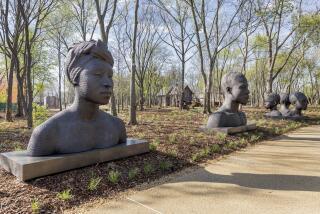Fort Mose: In St. Augustine, Fla., a celebration of black history
“One has not only a legal but a moral responsibility to
obey just laws. Conversely, one has a moral responsibility
to disobey unjust laws. I would agree with St. Augustine that
‘an unjust law is no law at all.’”
The Rev. Martin Luther King Jr.
“Letter From a Birmingham Jail”
April 16, 1963
St. Augustine is not only the patron saint of theologians such as the Rev. Martin Luther King Jr., but also the namesake of the oldest city in the U.S. And in 1964, as St. Augustine prepared to celebrate its 400th anniversary, the famed civil rights leader came here to denounce racial segregation.
“We’re preparing for a long, hot summer [across the country], and we see our push here in St. Augustine as a purifying prelude,” King told supporters that June.
Racial tension was near the boiling point that summer in this charming community on the Atlantic. Black marchers carrying placards saying, “Let us all see eye to eye” and “I’m an American, also” were greeted by white crowds who hurled jeers and bottles at the protestors and waved signs saying, “Don’t jive with my freedom” and “Kill [the] Civil Rights Bill.”
Ironically, blacks seeking civil rights had found those rights here more than 200 years earlier. As visitors discover, the roots of equality were planted in St. Augustine in 1738.
In the 18th century, the nation’s first underground railroad didn’t move escaped slaves north. Instead, they traveled south from plantations in the Carolinas to St. Augustine, where Spanish settlers at Ft. Mose granted liberty to the 100 or so who survived the arduous journey.
“There was no I-95 or U.S. 1,” says Thomas Jackson, a leader of the Fort Mose Historical Society. “You had palmetto bushes, bobcats, alligators — all of that along the way.”
Each February (Feb. 12 this year), Jackson dons a white, ruffled shirt, scarlet leggings and a royal blue tunic to portray a captain in the Mose Militia, an all-black unit created to protect the Spanish stronghold. The reenactment of the so-called Flight to Freedom takes place at the state historic park where the fort once stood.
PLANNING YOUR TRIP
THE BEST WAY TO ST. AUGUSTINE, FLA.
From LAX, Southwest offers direct service (stop, no change of plane) to Jacksonville, Fla., about 47 miles from St. Augustine. Delta, Continental, American, US Airways, AirTran, Southwest and Jet Blue offers connecting service (change of planes). Restricted round-trip fares begin at $248.
WHAT TO DO
This year’s “Flight to Freedom” living history event takes place Feb. 12 at Ft. Mose Historic State Park, (904) 823-2232, https://www.floridastateparks.org/fortmose. Admission is $4 a car.
TO LEARN MORE
St. Augustine, Ponte Vedra and the Beaches Visitors & Convention Bureau, (800) 653-2489, https://www.floridashistoriccoast.com, has brochures about the city’s historic sites, including the Freedom Trail, Fort Mose and Castillo de San Marcos.
“It’s a first-person interpretation of the slaves’ trek down from the Carolinas,” Jackson said. “When the visitors come to the site, they’re told that they’ll be meeting characters along a wooded trail.”
The first interpreter is “Rebecca,” a young woman who told of the dangers runaway slaves encountered. Probably more feared than any wild beast were the slave hunters, one of whom greets visitors farther down the trail.
“He’s searching for Rebecca,” Jackson said. “It’s just a job to him, to support his family [and] to return property to its rightful owner. He’s not a real popular character [along the walk], but history is what it is.”
Eventually, the visitors meet Jackson, dressed smartly in his officer’s uniform. A handful of men then demonstrate their skills with rudimentary muskets.
During the civil rights movement more than two centuries later, other blacks would seek sanctuary inside St. Augustine’s oldest African American church — Trinity United Methodist — as they retreated from angry white mobs. The church is now a stop along the city’s Freedom Trail.
A marker on the front lawn describes the church as a place where leaders met to plan their peaceful protests.
“Their courage and determination impressed the world and led to the passage of the landmark Civil Rights Act of 1964,” the plaque says. Just across Bridge Street, outside No. 83, another marker begins with the words “Martin Luther King Slept Here.” This house, like the one next door, is one of several in which King stayed.
“Because of tension, violence and fear of attack, it was unsafe for Dr. King to spend more than one night at a single location. Consequently, he was moved about regularly,” the marker says.
When Jackson was a teenager, he served as a “runner,” shadowing other blacks at demonstration sites, including the Woolworth lunch counter.
“They would go in and sit at the counter and ask for service,” he says. “I would observe and then report as to whether the group was arrested, whether there was any violence, [and] what number was on the vehicle that took the demonstrators away.”
Jackson didn’t learn until he went to college that a fort guarded by blacks had indeed existed in his hometown. While growing up, he thought people were confusing Ft. Mose with the majestic Spanish fort, Castillo de San Marcos, north of downtown.
“There was always a wives’ tale that we had our own fort,” Jackson says. “It just wasn’t believable.”
More to Read
Sign up for The Wild
We’ll help you find the best places to hike, bike and run, as well as the perfect silent spots for meditation and yoga.
You may occasionally receive promotional content from the Los Angeles Times.






